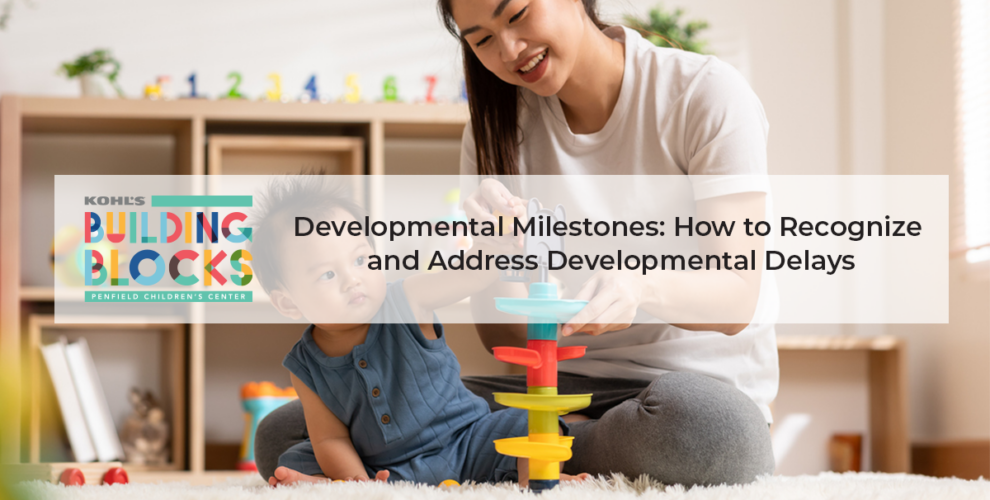Parents, caretakers, physicians, and early childhood educators play a crucial role in monitoring developmental milestones in early childhood and identifying children with suspected delays. Recognizing and addressing these issues early can help children access and benefit from essential services.
While every child is unique and develops at their own pace, most children acquire new skills in a predictable order. The list of developmental milestones below can help identify potential signs of developmental delays in early childhood.
Communication
Typical Developmental Milestones:
- Infants: Distinguish between happy and angry voices within weeks of birth.
- 1 Year: Use 3 to 10 words consistently.
- 2 Years: Utilize two to three-word phrases and engage in two-way communication.
- 3 Years: Speak in complete sentences.
- 5 Years: Understand quantity concepts, label smaller body parts, form grammatically correct questions, and describe similarities.
Communication Red Flags:
- Not talking by 18 months.
- Not attempting to communicate needs and wants at 12 months.
- No recognition of common objects at 18 months.
- Unable to understand simple commands at 12 months.
- Difficulty being understood less than 50% of the time at 2 years.
- Stuttering or lack of fluency in speech after 4 years.
- Unable to initiate conversations or ask questions at 2 ½ years.
- Not using pronouns appropriately at 2 years.
Learn more about specific language development milestones here.
Fine Motor Skills
Typical Developmental Milestones:
- Birth to 3 Months: Bring hands to mouth, grasp and hold objects.
- 1 Year: Stack blocks and turn pages in a book.
- 2 Years: Imitate scribbles and complete simple puzzles.
- 3 Years: String beads and use good hand and finger coordination.
- 4 to 5 Years: Color within lines, copy shapes, and use scissors.
Fine Motor Red Flags:
- Abnormal movement or extension/arching at 3 to 6 months.
- Extreme variations in muscle tone at birth to 3 months.
- Highly favored head position at 2 months.
- Not walking independently by 18 months.
- Extreme toe walking at 2 years.
- Hands remain fisted after 2 months.
- Sensory concerns such as aversions to textures or movements.
- Difficulty with hand-finger coordination.
Gross Motor Skills
Typical Developmental Milestones:
- Birth: Turn heads from side-to-side.
- 3 Months: Roll in both directions.
- 1 Year: Squat and resume a standing position.
- 12 to 18 Months: Begin walking independently.
- 2 Years: Use stairs independently, jump, run, and enjoy ‘rough and tumble’ play.
- 3 Years: Hop on one foot and avoid obstacles.
- 4 to 5 Years: Improved balance, coordination, and agility.
Gross Motor Red Flags:
- Abnormal movement or extension/arching at 3 to 6 months.
- Extreme variations in muscle tone at birth to 3 months.
- Highly favored head position at 2 months.
- Not walking independently by 18 months.
- Extreme toe walking at 2 years.
- Hands remain fisted after 2 months.
- Sensory concerns such as aversions to textures or movements.
- Difficulty with hand-finger coordination.
Cognition
Typical Developmental Milestones:
- Infants: Momentarily look at an object, turn head toward sound, explore with hands.
- 1 Year: Put objects into a container and dump them out, move around barriers to get toys.
- 2 Years: Sort shapes, understand ‘one’, complete simple puzzles.
- 3 Years: Enjoy pretend play, show interest in how things work.
- 4 to 5 Years: Identify shapes, numbers, letters, colors, and understand size concepts.
Cognition Red Flags:
- No eye contact at 3 months.
- No exploration of toys at 6 months.
- Not reaching for toys at 9 months.
- Lack of interest in playing with toys at 9 months.
- Easily distracted, extremely short attention span at 12 months.
- Inability to retain information at 12 months.
- Difficulty focusing on activities at 18 months.
- Preference to play alone all the time at 3 years.
- No cooperative play at 5 years.
Behavior Red Flags
- Negative behavior occurs multiple times per day.
- No self-calming and difficulty calming with intervention.
- Self-injury (head-banging, hitting, etc.).
- Behavioral interventions fail and do not impact behavior.
- Negative behavior persists despite routine and structure.
If you suspect a developmental delay, it is crucial to talk to your child’s pediatrician about the possible need for early intervention services.
Early intervention is a system that assesses children ages 0-3 for developmental delays or disabilities, focusing on helping them acquire typical developmental skills within the first three years of life.
How to Connect with Early Intervention Programs:
Ask Your Child’s Pediatrician: Request a referral.
Visit State Agencies’ Websites: Search for the early intervention office in your state.
Contact Local Pediatric Hospitals: Inquire about early intervention programs in your area.
Use National Resources: The National Early Childhood Technical Assistance Center (NECTAC) provides information and contacts for state programs under IDEA.
For children over three years old, services are provided free of charge through the public school system. Contact your local school to inquire about an evaluation through IDEA, the nation’s special education law.
Tracking developmental milestones in early childhood can significantly aid in identifying if your child needs early intervention services.
Additional developmental milestones resources:
Language development milestones
Fine motor skills development
Developmental milestones year one
Adapted from the National Center for Learning Disabilities Every Child is Learning: A Training Program for Parents and Teachers.



Leave a Reply